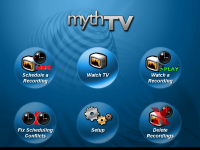Home Server: Media Center
Because a file archive is stored on the home server (video, music, photos), I wanted
implement a media center to view content using a TV / monitor right from
server.

media center written in Python, which makes it easy to extend it with plugins. There are plugins
for watching videos from YouTube, photos from flickr, Picasa, listening to streaming radio
SHOUTcast. Pretty nice design, somewhat similar to the Apple FrontRow. Because based on
GStreamer, that is, support for most popular media formats, but for example, for me
I did not want to read VOB files from DVD, although it showed a preview. Management is possible as with the keyboard,
and with the mouse (very convenient in the case of a wireless mouse), there is also integration with the LIRC for
remote control, you can configure and use the touchscreen. Customization occurs mainly in
configuration file, through the menu you can
just change topics. For initial setup, it’s enough just to add directory addresses to
which media files are stored in the [xmlmenu: locations_builder] section, the locations variable,
should take the form of a python array with paths: ['file: /// stuff',
'file: /// home / ftp / incoming'] ,
A configuration file is created in ~ / .elisa / elisa.conf after the first launch. The
media center has a huge number of settings, but they are all in the configuration file.
There is, for example, such an interesting opportunity as synchronization with the F-Spot.

Very interesting media center, originally written under xbox, but later ported to Linux,
Mac OS X, Windows. It has many beautiful themes, and a large number of ready-made scripts. Scripts
represent Python code and WindowXML (a framework for creating a graphical interface on
XML based. Among the scripts there are both simple plugins for services and quite complex ones.
Applications, such as email client, a variety of games. There is support for DVD, including like
as with the menu. Keyboard and mouse controls (since the cursor is used by its own and quite
large, the mouse is quite convenient to use), you can also use LIRC. All settings
are in the menu, and there are quite a few of them, besides the settings via the standard menu there is a web interface,
but I could not use it. There is support for subtitles, beautiful visualization of the current
songs, there is a sync with Last.fm. In general, this media center has left a very pleasant
impressions of the finished product, but sometimes there are problems with stability.
Warning: in the current build under ubuntu problems with the screen resolution, you need
use svn assembly.

Probably the most famous media center for linux. Pretty heavy resolute, because in ubuntu
pulls a lot of dependencies. Able to work with tv-tuner, keep records of programs.
MySQL database is required. Control from keyboards and through LIRC, there is no mouse control.
Quite complicated to set up, but has support for DVB cards (satellite TV, cable, and
etc.). Supports distribution to multiple servers, video encoding. In fact
pretty redundant solution, I think, because video recording / encoding is easy to set up
over the crown. It has a large number of plug-ins.
')
Initially, we will need an X.org server, since Initially it is not in the ubuntu-server:
Next, install the media center you like:
Caution: for XBMC you must use
third-party repository , preferably with
SVN assemblies, because in the normal assembly there is a problem with the screen resolution
Create a user in the home directory from which the media center file will be launched.
.xinitrc and write to it:
Now you need to configure the automatic launch of X from a user, without prompting
password, to do this, add to /etc/rc.local line to exit 0 :
If you get the error X: user not authorized to run the X server, aborting. at
boot, you need to change your X11 settings:
And allow anyone to run the X11 server.
Attention: because this is a potential security hole, then you need to ban remote
connect to X11 server
That's all, now the media center starts automatically after a reboot.
Other articles in this series: Xen-based virtualization , proxy for SIP
cross post from my blog
implement a media center to view content using a TV / monitor right from
server.
Software solutions for Linux-based media center
Elisa

media center written in Python, which makes it easy to extend it with plugins. There are plugins
for watching videos from YouTube, photos from flickr, Picasa, listening to streaming radio
SHOUTcast. Pretty nice design, somewhat similar to the Apple FrontRow. Because based on
GStreamer, that is, support for most popular media formats, but for example, for me
I did not want to read VOB files from DVD, although it showed a preview. Management is possible as with the keyboard,
and with the mouse (very convenient in the case of a wireless mouse), there is also integration with the LIRC for
remote control, you can configure and use the touchscreen. Customization occurs mainly in
configuration file, through the menu you can
just change topics. For initial setup, it’s enough just to add directory addresses to
which media files are stored in the [xmlmenu: locations_builder] section, the locations variable,
should take the form of a python array with paths: ['file: /// stuff',
'file: /// home / ftp / incoming'] ,
A configuration file is created in ~ / .elisa / elisa.conf after the first launch. The
media center has a huge number of settings, but they are all in the configuration file.
There is, for example, such an interesting opportunity as synchronization with the F-Spot.
Xbmc

Very interesting media center, originally written under xbox, but later ported to Linux,
Mac OS X, Windows. It has many beautiful themes, and a large number of ready-made scripts. Scripts
represent Python code and WindowXML (a framework for creating a graphical interface on
XML based. Among the scripts there are both simple plugins for services and quite complex ones.
Applications, such as email client, a variety of games. There is support for DVD, including like
as with the menu. Keyboard and mouse controls (since the cursor is used by its own and quite
large, the mouse is quite convenient to use), you can also use LIRC. All settings
are in the menu, and there are quite a few of them, besides the settings via the standard menu there is a web interface,
but I could not use it. There is support for subtitles, beautiful visualization of the current
songs, there is a sync with Last.fm. In general, this media center has left a very pleasant
impressions of the finished product, but sometimes there are problems with stability.
Warning: in the current build under ubuntu problems with the screen resolution, you need
use svn assembly.
MythTV

Probably the most famous media center for linux. Pretty heavy resolute, because in ubuntu
pulls a lot of dependencies. Able to work with tv-tuner, keep records of programs.
MySQL database is required. Control from keyboards and through LIRC, there is no mouse control.
Quite complicated to set up, but has support for DVB cards (satellite TV, cable, and
etc.). Supports distribution to multiple servers, video encoding. In fact
pretty redundant solution, I think, because video recording / encoding is easy to set up
over the crown. It has a large number of plug-ins.
')
Installation and Setup
Initially, we will need an X.org server, since Initially it is not in the ubuntu-server:
apt-get install xorg
Next, install the media center you like:
apt-get install elisa (xbmc / mythtv)
Caution: for XBMC you must use
third-party repository , preferably with
SVN assemblies, because in the normal assembly there is a problem with the screen resolution
Create a user in the home directory from which the media center file will be launched.
.xinitrc and write to it:
exec elisa (or xbmc / mythtv)
Now you need to configure the automatic launch of X from a user, without prompting
password, to do this, add to /etc/rc.local line to exit 0 :
su - username -c startx
If you get the error X: user not authorized to run the X server, aborting. at
boot, you need to change your X11 settings:
dpkg-reconfigure x11-common
And allow anyone to run the X11 server.
Attention: because this is a potential security hole, then you need to ban remote
connect to X11 server
That's all, now the media center starts automatically after a reboot.
Other articles in this series: Xen-based virtualization , proxy for SIP
cross post from my blog
Source: https://habr.com/ru/post/37864/
All Articles